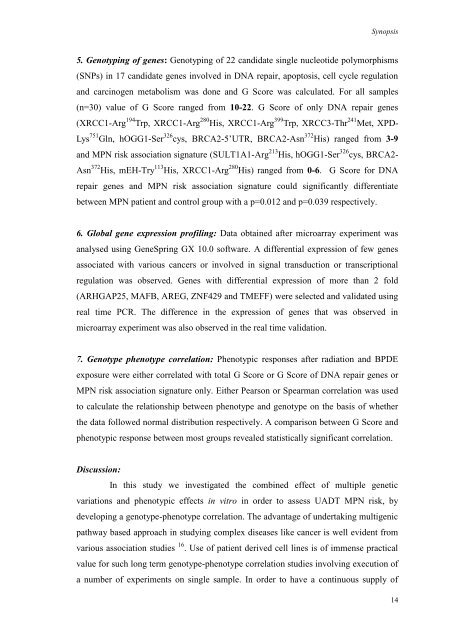LIFE09200604007 Tabish - Homi Bhabha National Institute
LIFE09200604007 Tabish - Homi Bhabha National Institute
LIFE09200604007 Tabish - Homi Bhabha National Institute
You also want an ePaper? Increase the reach of your titles
YUMPU automatically turns print PDFs into web optimized ePapers that Google loves.
Synopsis<br />
5. Genotyping of genes: Genotyping of 22 candidate single nucleotide polymorphisms<br />
(SNPs) in 17 candidate genes involved in DNA repair, apoptosis, cell cycle regulation<br />
and carcinogen metabolism was done and G Score was calculated. For all samples<br />
(n=30) value of G Score ranged from 10-22. G Score of only DNA repair genes<br />
(XRCC1-Arg 194 Trp, XRCC1-Arg 280 His, XRCC1-Arg 399 Trp, XRCC3-Thr 241 Met, XPD-<br />
Lys 751 Gln, hOGG1-Ser 326 cys, BRCA2-5‟UTR, BRCA2-Asn 372 His) ranged from 3-9<br />
and MPN risk association signature (SULT1A1-Arg 213 His, hOGG1-Ser 326 cys, BRCA2-<br />
Asn 372 His, mEH-Try 113 His, XRCC1-Arg 280 His) ranged from 0-6. G Score for DNA<br />
repair genes and MPN risk association signature could significantly differentiate<br />
between MPN patient and control group with a p=0.012 and p=0.039 respectively.<br />
6. Global gene expression profiling: Data obtained after microarray experiment was<br />
analysed using GeneSpring GX 10.0 software. A differential expression of few genes<br />
associated with various cancers or involved in signal transduction or transcriptional<br />
regulation was observed. Genes with differential expression of more than 2 fold<br />
(ARHGAP25, MAFB, AREG, ZNF429 and TMEFF) were selected and validated using<br />
real time PCR. The difference in the expression of genes that was observed in<br />
microarray experiment was also observed in the real time validation.<br />
7. Genotype phenotype correlation: Phenotypic responses after radiation and BPDE<br />
exposure were either correlated with total G Score or G Score of DNA repair genes or<br />
MPN risk association signature only. Either Pearson or Spearman correlation was used<br />
to calculate the relationship between phenotype and genotype on the basis of whether<br />
the data followed normal distribution respectively. A comparison between G Score and<br />
phenotypic response between most groups revealed statistically significant correlation.<br />
Discussion:<br />
In this study we investigated the combined effect of multiple genetic<br />
variations and phenotypic effects in vitro in order to assess UADT MPN risk, by<br />
developing a genotype-phenotype correlation. The advantage of undertaking multigenic<br />
pathway based approach in studying complex diseases like cancer is well evident from<br />
various association studies 16 . Use of patient derived cell lines is of immense practical<br />
value for such long term genotype-phenotype correlation studies involving execution of<br />
a number of experiments on single sample. In order to have a continuous supply of<br />
14

















